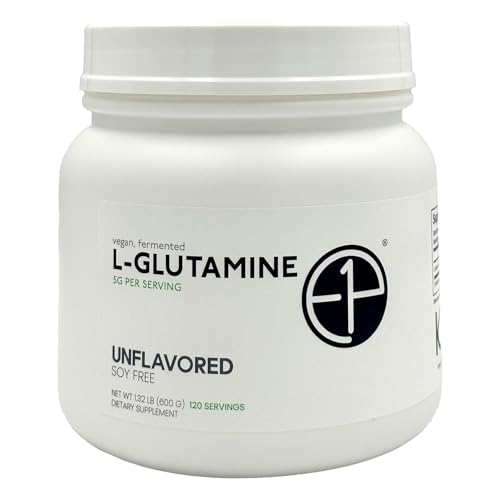Glutamine
Overview
Glutamine is a conditionally essential, non-essential amino acid that serves as the most abundant free amino acid in human plasma and intracellularly. It functions primarily as:
- A nitrogen carrier
- A substrate for rapid-dividing cells (e.g., enterocytes, immune cells, and fibroblasts)
- A key precursor for nucleotides, glutathione, and other amino acids, supporting both metabolic and immune processes.
Benefits
- Gut integrity: Oral glutamine improves intestinal barrier function and reduces permeability, especially after intense exercise or chemotherapy (e.g., reduced lactulose/mannitol ratios).
- Immune support: It fuels lymphocytes and macrophages, modestly enhancing NK-cell activity and attenuating infection risk in athletes and postoperative patients.
- Recovery & muscle: While not a potent anabolic agent, glutamine supplementation can attenuate muscle soreness and preserve lean mass during catabolic stress (e.g., trauma, prolonged training).
- Cognitive & mood: Emerging data suggest glutamine may support neurotransmitter balance (glutamate/GABA) and modestly improve mental fatigue in high-stress settings, though evidence remains preliminary.
- Metabolic health: Glutamine contributes to glucose homeostasis via gluconeogenesis and may improve insulin sensitivity in certain metabolic-disorder models, though human data are mixed.
How It Works
- Glutamine enters cells via sodium-dependent transporters (e.g., SLC1A5, SLC7A5) and is de-amidated by glutaminase to produce glutamate and ammonia.
- Glutamate then serves as a substrate for glutamate-dehydrogenase, feeding the TCA cycle (anaplerosis) and supporting ATP production in proliferative cells.
- In the gut, glutamine fuels enterocyte ATP generation, supports tight-junction protein synthesis, and drives production of the antioxidant glutathione via the γ-glutamyl cycle.
- In immune cells, glutamine provides carbon and nitrogen for nucleotide synthesis, enhancing proliferation and cytokine production.
- In the brain, glutamine acts as a precursor for the excitatory neurotransmitter glutamate and the inhibitory neurotransmitter GABA, influencing neuronal excitability and cognition.
Dosage
- Typical supplemental doses range from 5 g to 15 g per day for healthy adults.
- For exercise-induced gut stress, 0.3–0.5 g/kg body weight (≈10–20 g) divided into 2–3 doses around workouts is common.
- Post-surgical or trauma patients may receive 0.3–0.5 g/kg/day in divided doses, guided by clinical nutritionists.
- For immune support, 5–10 g daily in the morning or post-exercise is typical.
- Timing: a dose 30–60 min before intense activity or after surgery may maximize uptake.
- In renal-compromised patients, lower doses (≤5 g) are advised, and dosing should be individualized.
Safety & Side Effects
- Glutamine is generally well-tolerated; the most frequent side effects are mild gastrointestinal discomfort (bloating, nausea).
- High doses (>30 g/day) may cause transient diarrhea or increased ammonia in patients with severe liver disease or urea-cycle defects.
- Contraindications include severe hepatic insufficiency, renal failure, and known hyper-ammonemia.
- Drug interactions are minimal but caution is advised with nitrogen-based chemotherapy (potentially altered metabolism) and seizure-threshold-lowering agents (due to glutamate excitatory potential).
- Pregnant or lactating women should consult a healthcare provider before use.
Chemistry
- Glutamine (IUPAC: 2-amino-4-carbamoylbutanoic acid) has the molecular formula C₅H₁₀N₂O₃ and a molecular weight of 146.15 g mol⁻¹.
- It is a polar, non-ionic amino acid at physiological pH, possessing an α-amino group, a side-chain amide (–CONH₂), and a carboxylate group.
- The side-chain amide renders it a neutral amino acid, distinct from acidic (aspartate) or basic (lysine) residues.
- Its pKa values are ~2.2 (carboxyl) and ~9.1 (α-amino).
- The amide side chain is a key donor/acceptor for hydrogen bonding, influencing its solubility (≈1 g mL⁻¹ in water) and its role as a nitrogen donor in biosynthetic pathways.
Sources & Quality
- Dietary glutamine is abundant in protein-rich foods: beef, chicken, fish, dairy, eggs, and plant sources such as beans, lentils, and nuts.
- Commercial supplements are typically fermentation-derived from Corynebacterium glutamicum or Bacillus subtilis cultured on glucose-rich media, producing a high-purity L-glutamine powder.
- Some manufacturers use chemical synthesis (e.g., Strecker synthesis) for research-grade material, but most commercial products are biotechnologically produced, yielding >99 % purity with minimal residual solvents.
- Quality considerations include: verification of L-isomer (the biologically active form), absence of heavy metals or microbial contaminants, and certification (e.g., GMP, NSF).
All statements are based on peer-reviewed literature up to 2024; individual responses may vary, and consultation with a qualified health professional is recommended before initiating supplementation.
Where to Buy Glutamine




Affiliate Disclosure: We earn a commission if you purchase through these links at no additional cost to you. This helps us maintain our research and provides you with the best supplement information.